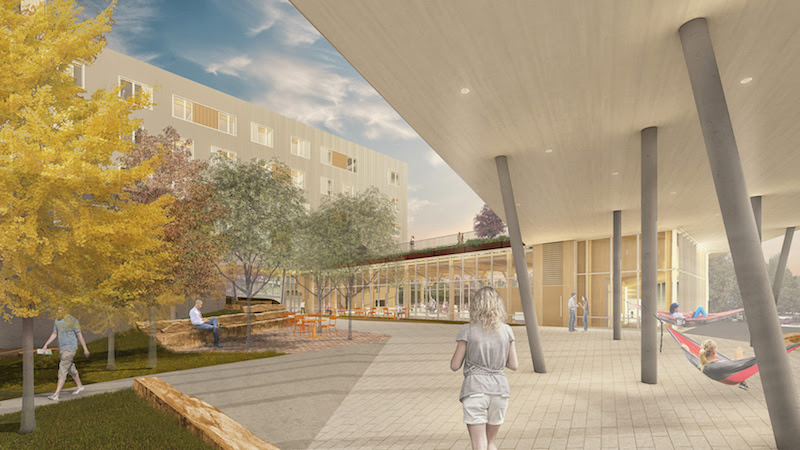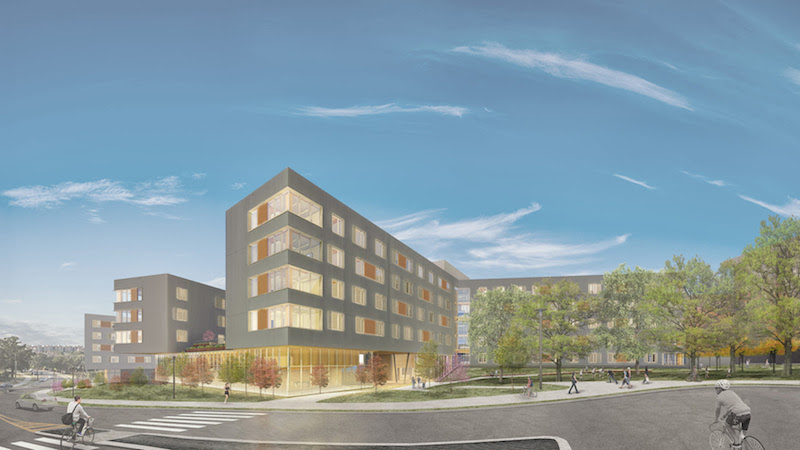The University of Arkansas’s new 202,027-sf, 708-bed residence hall, dubbed the Stadium Drive Residence Halls, is set to become the first large-scale mass timber residence hall and living learning setting in the country.
The project is currently under construction on a linear four-acre site that slopes from north to south. Within this relatively small, densely planted buffer zone the project is shaped by the concept of “a cabin in the woods” that provides a new university gateway. A serpentine band of student rooms defines three protected and distinctive courtyard spaces.
 Rendering courtesy Leers Weinzapfel Associates, Modus Studios, Mackey Mitchell
Rendering courtesy Leers Weinzapfel Associates, Modus Studios, Mackey Mitchell
The north building includes a “front porch” that is the main entry point of the complex and a “cabin” at the passage’s midpoint that is the main gathering space. The “cabin” includes a community kitchen, lounges, a quiet hearth, and a rooftop terrace. The lower courtyard includes workshops that comprise performance spaces, music and recording studios, and maker spaces.
Student rooms are arranged in wings that comprise semi-suites for two students and pods for six to eight students. Study rooms at the end of each wing are naturally lit via large windows and create a series of “lanterns” along Stadium Drive. The buildings’ inner cores feature two-story lounges with residential kitchens designed for community interaction between the upper and lower floors.
Wood is on full display throughout the project with exposed structural wood ceilings present in student rooms, study rooms, floor lounges, and ground-level common spaces. The “cabin” also includes wood ceilings and trusses that span the full width of the lounges.
 Rendering courtesy Leers Weinzapfel Associates, Modus Studios, Mackey Mitchell
Rendering courtesy Leers Weinzapfel Associates, Modus Studios, Mackey Mitchell
The exterior of the project highlights metal. Zinc-toned siding with accent panels of textured copper-toned and white siding creates a floating band of living space above the natural landscape. A ground-level passage winds through the landscape and connects the various courtyards.
The project, which is the result of a design collaborative led by Leers Weinzapfel Associates, Modus Studio, Mackey Mitchell Architects, and OLIN is scheduled for completion in fall 2019.
Related Stories
| Aug 11, 2010
New data shows low construction prices may soon be coming to an end
New federal data released recently shows sharp increases in the prices of key construction materials like diesel, copper and brass mill shapes likely foreshadow future increases in construction costs, the Associated General Contractors of America said. The new November producer price index (PPI) report from the Bureau of Labor Statistics provide the strongest indication yet that construction prices are heading up, the association noted.
| Aug 11, 2010
LEED 2009 cites FloorScore Certification as indicator of indoor air quality
The U.S. Green Building Council (USGBC) has cited FloorScore® certified flooring products as eligible for credits under the new LEED 2009 Version 3 guidelines. Reflecting the inclusion of FloorScore, the new LEED IEQ Credit 4.3 for Low-Emitting Materials has been expanded from “Carpet Systems” to “Flooring Systems” to include hard surface flooring.
| Aug 11, 2010
Southern Pine Council releases certification survey results
Recent surveys conducted by the Southern Forest Products Association (SFPA) and Random Lengths assessed the use of forest certification programs in the wood products industry and uncovered interesting results, including the fact that approximately 61% do not use a certification system and that about 60% of southern pine producers receive regular requests for certified products.
| Aug 11, 2010
Best AEC Firms of 2011/12
Later this year, we will launch Best AEC Firms 2012. We’re looking for firms that create truly positive workplaces for their AEC professionals and support staff. Keep an eye on this page for entry information. +
| Aug 11, 2010
AAMA leads development of BIM standard for fenestration products
The American Architectural Manufacturers Association’s newly formed BIM Task Group met during the AAMA National Fall Conference to discuss the need for an BIM standard for nonresidential fenestration products.
| Aug 11, 2010
Pella Corporation ranks highest in customer satisfaction
Pella Corporation has earned the prestigious J.D. Power and Associates award for “Highest in Customer Satisfaction among Window and Patio Door Manufacturers” for the third year in a row.
| Aug 11, 2010
Pella introduces BIM models for windows and doors
Pella Corporation now offers three-dimensional (3D) window and door models for use in Building Information Modeling (BIM) projects by architects, designers, and others looking for aesthetically correct, easy-to-use, data-rich 3D drawings.
| Aug 11, 2010
AAMA developing product-based green certification program for fenestration
The American Architectural Manufacturers Association is working on a product-based green certification program for residential and commercial fenestration, the organization announced today. AAMA will use the results of a recent green building survey to help shape the program. Among the survey's findings: 77% of respondents reported a green certification program for fenestration would benefit the product selection process for their company.
| Aug 11, 2010
AIA Course: Enclosure strategies for better buildings
Sustainability and energy efficiency depend not only on the overall design but also on the building's enclosure system. Whether it's via better air-infiltration control, thermal insulation, and moisture control, or more advanced strategies such as active façades with automated shading and venting or novel enclosure types such as double walls, Building Teams are delivering more efficient, better performing, and healthier building enclosures.
| Aug 11, 2010
World's tallest all-wood residential structure opens in London
At nine stories, the Stadthaus apartment complex in East London is the world’s tallest residential structure constructed entirely in timber and one of the tallest all-wood buildings on the planet. The tower’s structural system consists of cross-laminated timber (CLT) panels pieced together to form load-bearing walls and floors. Even the elevator and stair shafts are constructed of prefabricated CLT.







